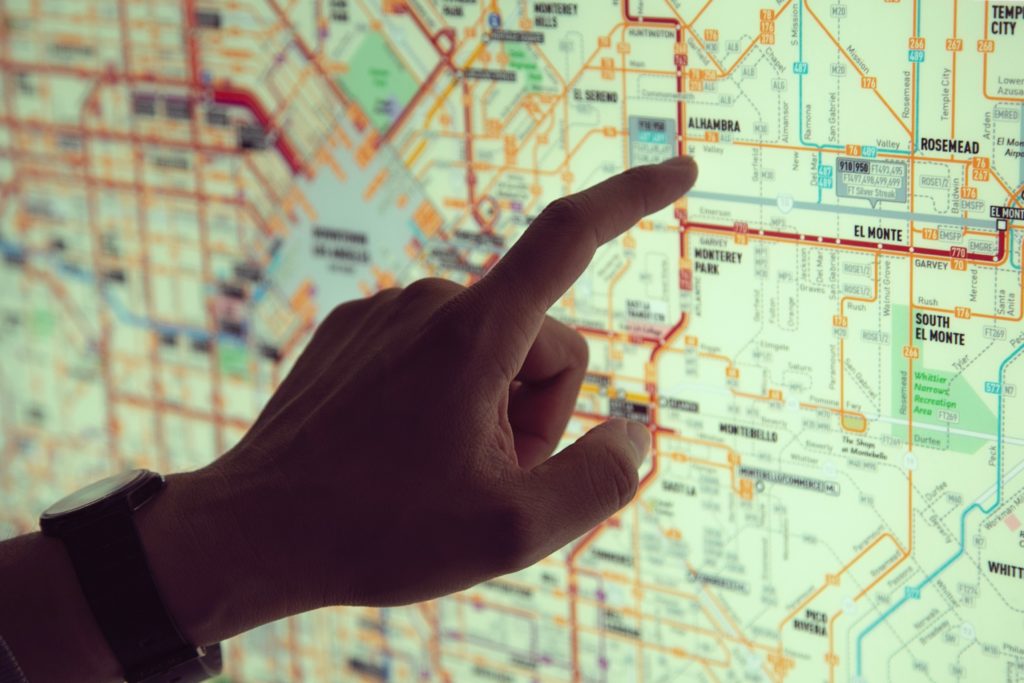Asking for / giving directions in Levantine Arabic Posted by Hanan Ben Nafa on Jun 28, 2021 in Arabic Language, Pronunciation, Vocabulary
We’re still learning about directions الاتجاهات for the second week. The post focuses on the main phrases and adverbs of place that one needs to know to be able to ask for directions as well as how to give them. While the previous post addressed the topic of directions in MSA, the current one will address it in Levantine Arabic.
Directions الاتجاهات
The most basic directions (adverbs of place) used are the following:
يمين right
يسار left
قدّام In front of
ورا behind
بجنب next to
مقابيل opposite to
على طول straight ahead
= = = = = = = =
Distance المسافة
When talking about how the distance to a certain place, there are 2 adjectives that can be used:
قريب near
بعيد far
قريب من هون
Close by here
بعيد من هون
Far from here
= = = = = = = =
عبارات للسؤال عن الاتجاهات
Phrases for asking for directions:
فيك تخبّرني كيف روح على الـ ……؟
Can you tell me how can I get to the ……?
……..أنا عم دوّر على الـ
I’m looking for the ……
وين بقدر لاقي أقرب ……؟
Where can find the closest ……?
بتعرف وين (مكان) الـ ……؟
Do you know where is (the location of) the …?
قدّيش بعيد الـ ….. من هون؟
How far is (…..) from here?
= = = = = = = =
عبارات عند إعطاء الاتجاهات
Phrases when giving directions:
كمّل على طول
Go straight ahead
خود يمين/ يسار
Go right/ left
لفّ عاليمين/ عاليسار
Turn right/ left
اقْطع الشارع
Cross the street
امشي مع هاد الطريق
Follow this street
…..خليك ماشي بجنب الـ
Continue walking beside the …..
خليك ماشي على طول هادا الشارع
Continue walking along the street
…..خليك ماشي لحتى توصل عالـ
Continue walking until you get to the ……
…..خليك ماشي لَبعد الـ
Continue walking past the ……
……. راح تلاقي قدّامك
You’ll find in front of you …….
……راح يكون المكان بين الـ……. و الـ
The place will be between the …… and the ……
……راح تلاقي الـ ……. مقابيل الـ
You’ll find the …… opposite to the …..
راح تمِرّ بطريقك على كم محل عاليمين
You’ll pass by some shops on your right
= = = = = = = =
المثال الأول
First Example:
مرحبا، بتعرف وين سوق السمك؟
Hello, do you know where the fish market is?
إيه، هو كتير قريب من هون<
Yes, it’s close by here.
طيب منيح
Ok, that’s good.
خلّيك ماشي على طول هادا الشارع<
Keep walking along this street straight ahead
راح تلاقي بآخره إشارة مرور<
You’ll find at the end of it a traffic light signal
لفّ (خود) عاليسار<
Turn left
خليك ماشي شي دقيقتين<
Keep walking for about 2 minutes
راح تلاقي جامع صغير عاليسار<
You’ll find a small mosque on your left
والسوق بعده على طول<
That market will be straight after it
= = = = = = = =
المثال الثاني
Second Example:
عفوًا، أنا عم دوّر على أقرب محطة بنزين، فيك تساعدني؟
Excuse me, I’m looking for the closest petrol station, can you help me?
إيه فيني ساعدك، المكان مو بعيد كتير من هون<
Yes, I can help you. The place is not very far from here.
شكرا إلك
Thank you.
كمّلي بهادا الشارع لحتى توصلي لمكتب البريد هاداك<
Follow this street until you get to that post office
خلّي مكتب البريد على اليمين<
Keep the post office on your right
ولفّي (خِدي) عاليسار<
And turn left
خليكي ماشيه<
Continue walking
راح تلاقي جسر كبير قِدّامِك<
You’ll find a big bridge right in front of you.
مرّي من تحت الجسر<
Walk under the bridge.
راح تلاقي المحطة عاليمين<
You’ll find the petrol station on the right.
= = = = = = = =

Build vocabulary, practice pronunciation, and more with Transparent Language Online. Available anytime, anywhere, on any device.




